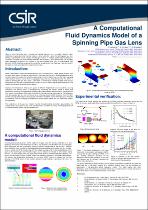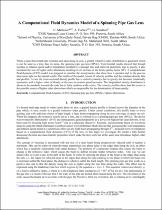JavaScript is disabled for your browser. Some features of this site may not work without it.
- ResearchSpace
- →
- Research Publications/Outputs
- →
- Conference Publications
- →
- View Item
| dc.contributor.author |
Mafusire, C

|
|
| dc.contributor.author |
Forbes, A

|
|
| dc.contributor.author |
Snedden, Glen C

|
|
| dc.date.accessioned | 2010-12-08T14:14:08Z | |
| dc.date.available | 2010-12-08T14:14:08Z | |
| dc.date.issued | 2010-08 | |
| dc.identifier.citation | Mafusire, C, Forbes, A and Snedden, GC. 2010. Computational fluid dynamics model of the spinning pipe gas lens. SPIE Optics + Photonics 2010, San Diego, California, USA, 1-5 August 2010, pp 1 | en |
| dc.identifier.uri | http://hdl.handle.net/10204/4635 | |
| dc.description | SPIE Optics + Photonics 2010, San Diego, California, USA, 1-5 August 2010 | en |
| dc.description.abstract | When a metal horizontal pipe is heated and spun along its axis, a graded refractive index distribution is generated which is can be used as a lens, thus its name, the spinning pipe gas lens (SPGL). Previous experimental results of its performance were done with a Shack-Hartmann sensor. The results showed that though increase in rotation speed and/or temperature resulted in a stronger lens (increase in negative defocus) and removed distortions due to gravity (decrease in y-tilt), it also increased the size of higher order aberrations resulting in an increase in the beam quality factor (M2). A computational fluid dynamics (CFD) model was prepared to simulate the aerodynamics that show how it operates and, in the process shed some light on the optical results. The model was based on the SPGL heated at 100 ºC operating from rest to a steady state at a speed of 20 Hz. The results consist of velocity profiles and the resultant density data and profiles. At rest the cross-sectional density profile has a vertical symmetry due to gravity but becomes rotationally symmetric with a higher value of density at the core as rotation speed increases. The longitudinal density distribution is shown to be parabolic towards the ends but is fairly uniform at the centre. The velocity profiles show that this centre is the possible source of higher order aberrations which are responsible for the deterioration of beam quality. | en |
| dc.language.iso | en | en |
| dc.relation.ispartofseries | POSTER | en |
| dc.subject | Spinning pipe gas lens | en |
| dc.subject | Aberrations | en |
| dc.subject | Beam quality | en |
| dc.subject | computational fluid dynamics | en |
| dc.subject | Optics | en |
| dc.subject | Photonics | en |
| dc.title | Computational fluid dynamics model of the spinning pipe gas lens | en |
| dc.type | Conference Presentation | en |
| dc.identifier.apacitation | Mafusire, C., Forbes, A., & Snedden, G. C. (2010). Computational fluid dynamics model of the spinning pipe gas lens. http://hdl.handle.net/10204/4635 | en_ZA |
| dc.identifier.chicagocitation | Mafusire, C, A Forbes, and Glen C Snedden. "Computational fluid dynamics model of the spinning pipe gas lens." (2010): http://hdl.handle.net/10204/4635 | en_ZA |
| dc.identifier.vancouvercitation | Mafusire C, Forbes A, Snedden GC, Computational fluid dynamics model of the spinning pipe gas lens; 2010. http://hdl.handle.net/10204/4635 . | en_ZA |
| dc.identifier.ris | TY - Conference Presentation AU - Mafusire, C AU - Forbes, A AU - Snedden, Glen C AB - When a metal horizontal pipe is heated and spun along its axis, a graded refractive index distribution is generated which is can be used as a lens, thus its name, the spinning pipe gas lens (SPGL). Previous experimental results of its performance were done with a Shack-Hartmann sensor. The results showed that though increase in rotation speed and/or temperature resulted in a stronger lens (increase in negative defocus) and removed distortions due to gravity (decrease in y-tilt), it also increased the size of higher order aberrations resulting in an increase in the beam quality factor (M2). A computational fluid dynamics (CFD) model was prepared to simulate the aerodynamics that show how it operates and, in the process shed some light on the optical results. The model was based on the SPGL heated at 100 ºC operating from rest to a steady state at a speed of 20 Hz. The results consist of velocity profiles and the resultant density data and profiles. At rest the cross-sectional density profile has a vertical symmetry due to gravity but becomes rotationally symmetric with a higher value of density at the core as rotation speed increases. The longitudinal density distribution is shown to be parabolic towards the ends but is fairly uniform at the centre. The velocity profiles show that this centre is the possible source of higher order aberrations which are responsible for the deterioration of beam quality. DA - 2010-08 DB - ResearchSpace DP - CSIR KW - Spinning pipe gas lens KW - Aberrations KW - Beam quality KW - computational fluid dynamics KW - Optics KW - Photonics LK - https://researchspace.csir.co.za PY - 2010 T1 - Computational fluid dynamics model of the spinning pipe gas lens TI - Computational fluid dynamics model of the spinning pipe gas lens UR - http://hdl.handle.net/10204/4635 ER - | en_ZA |







